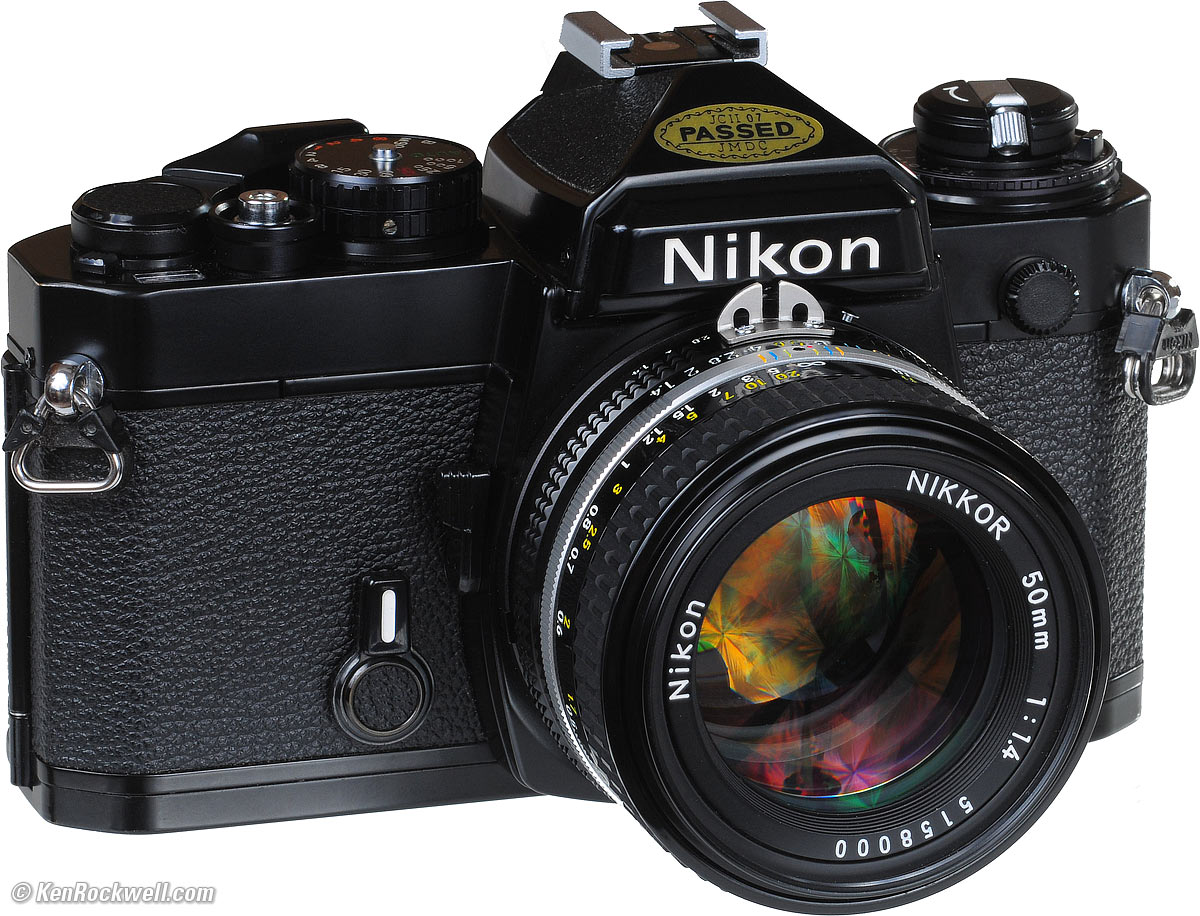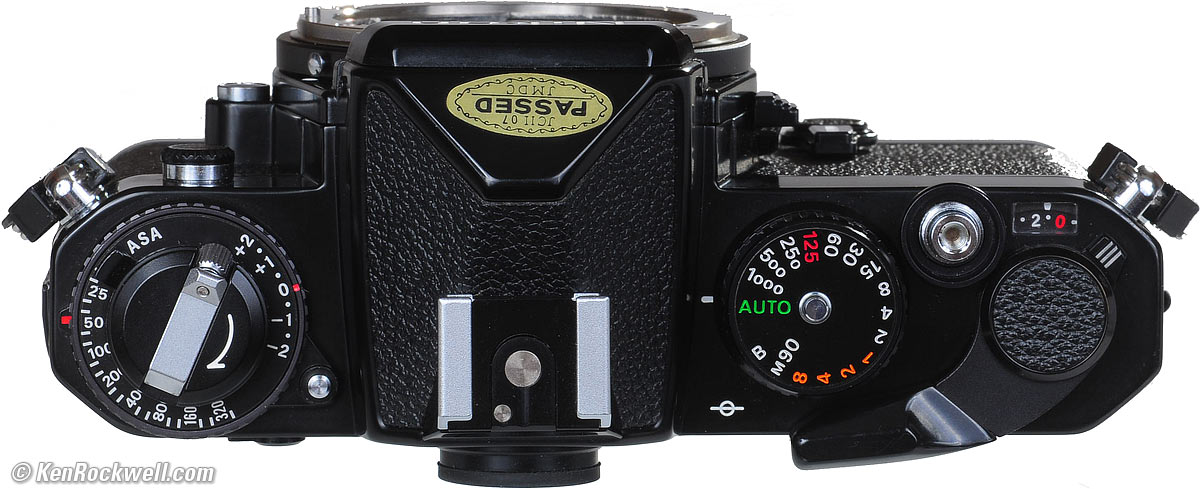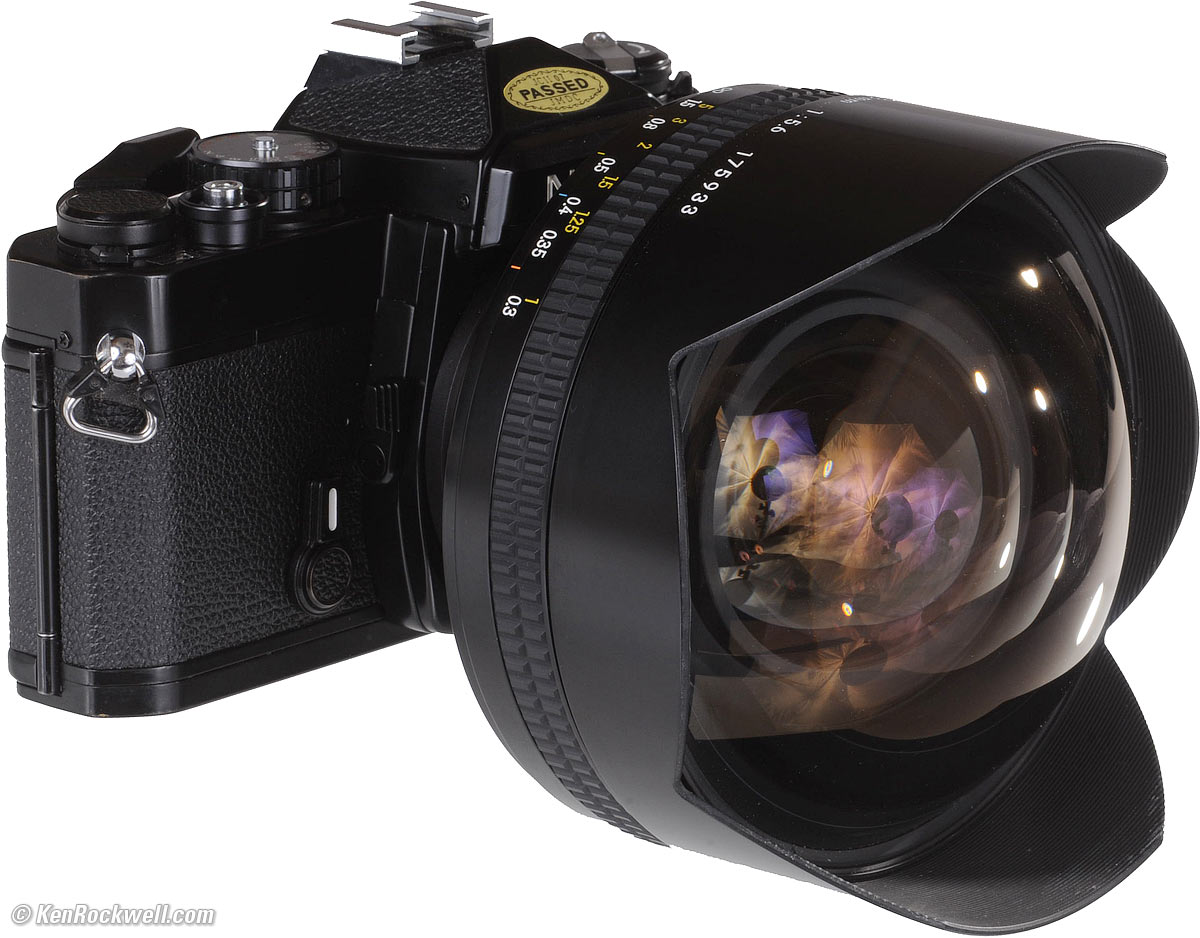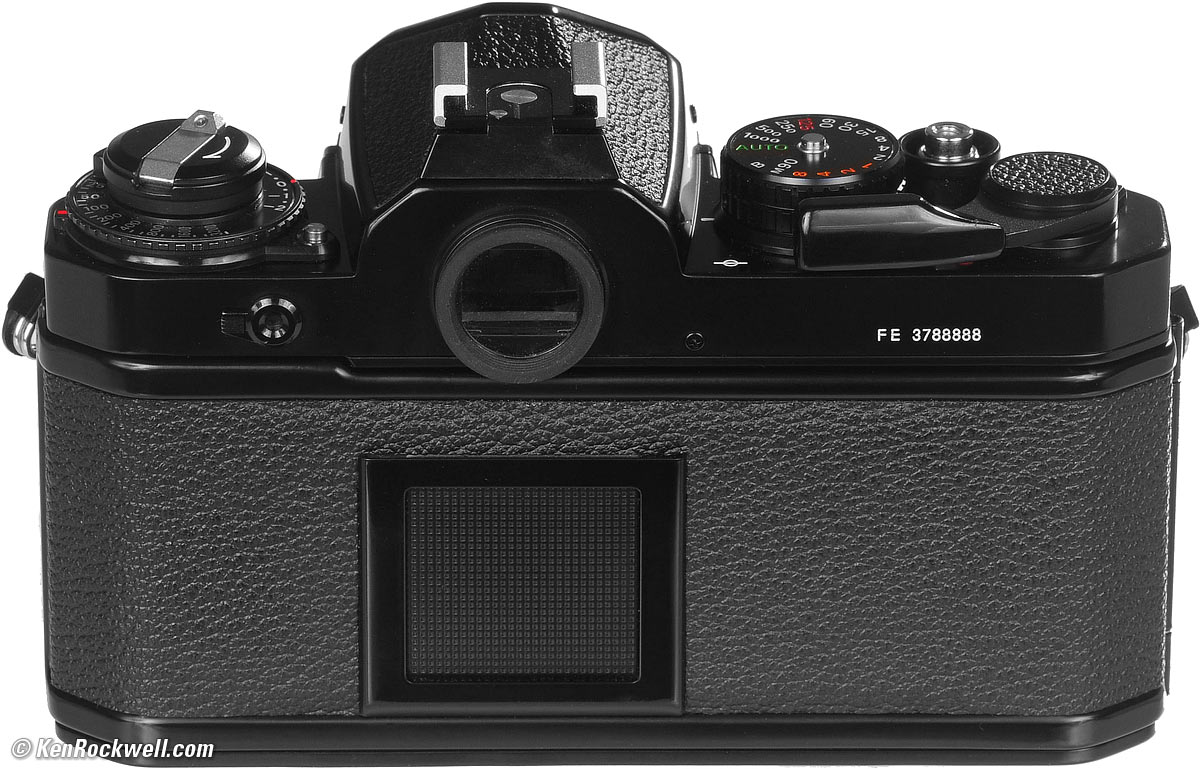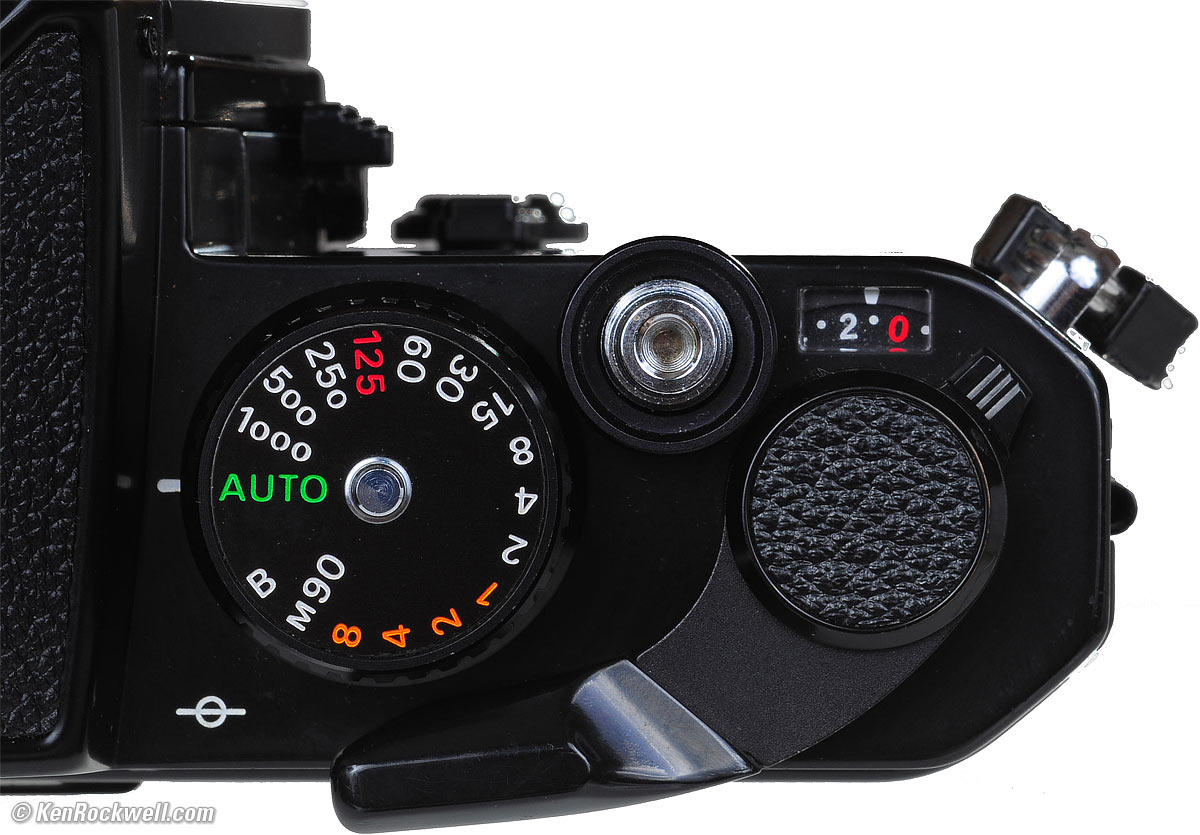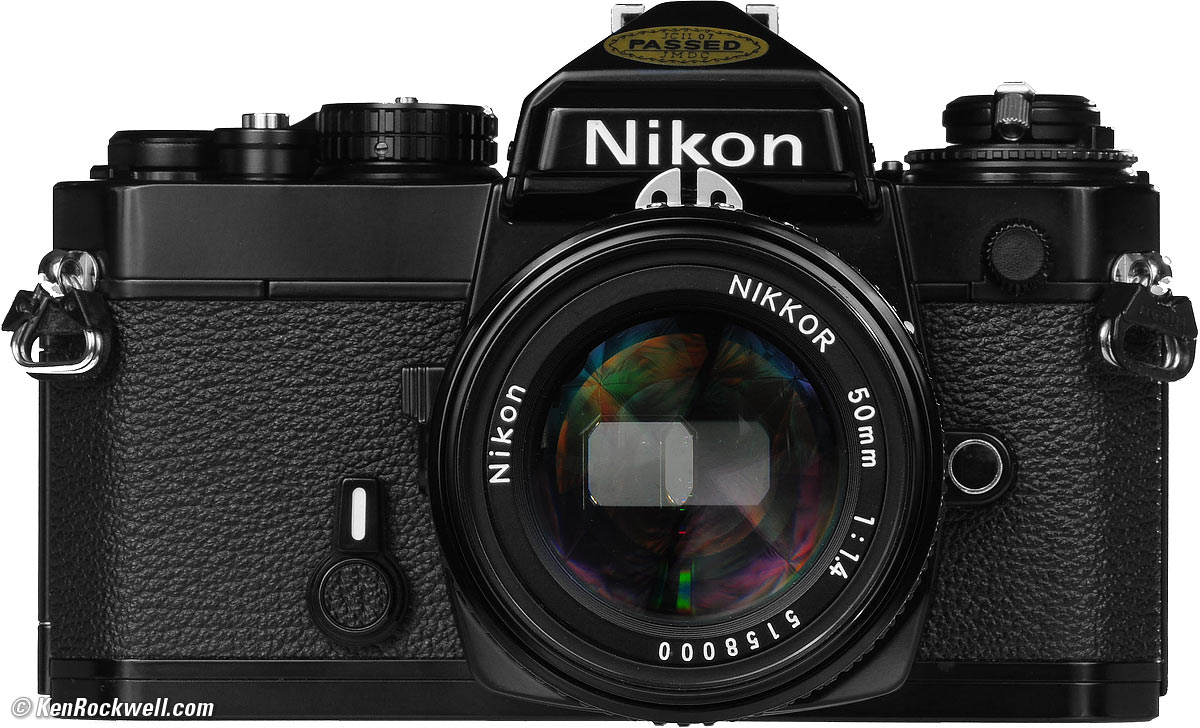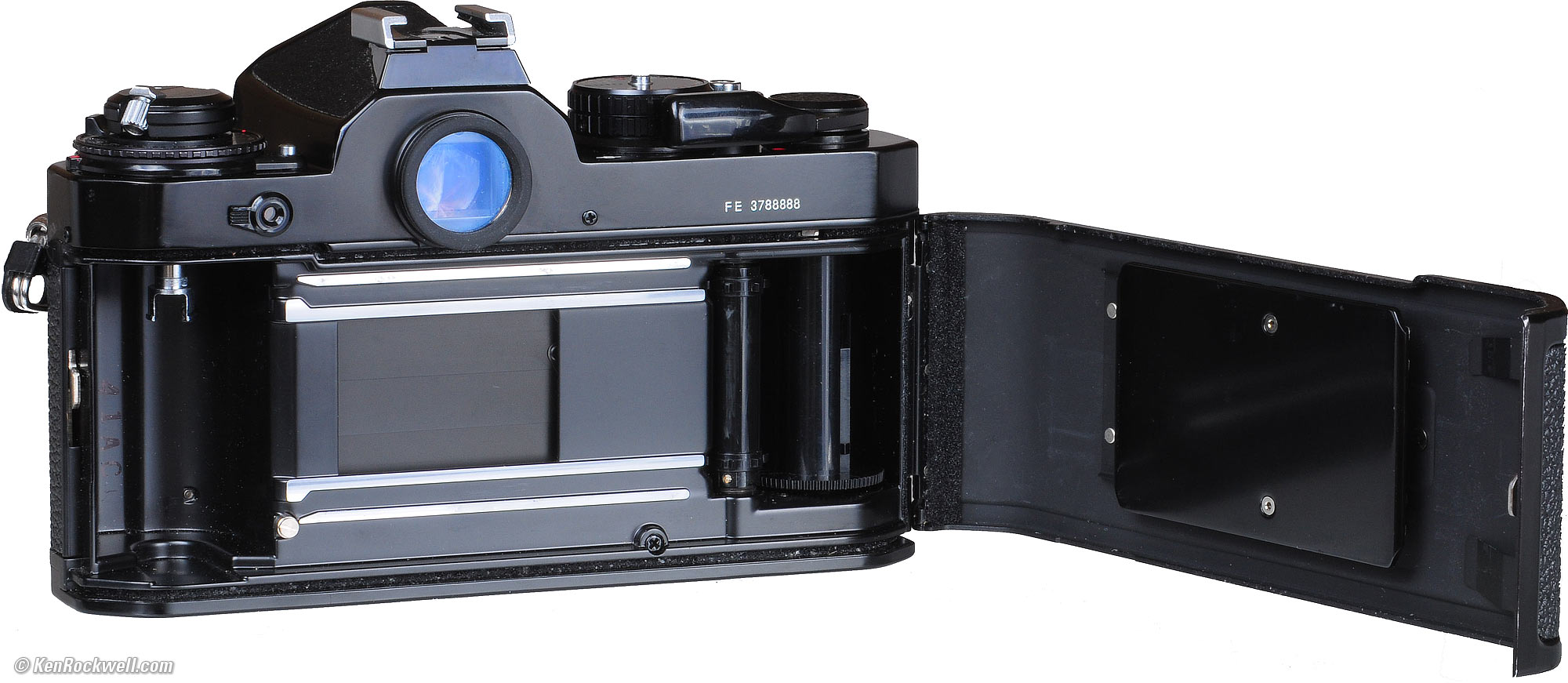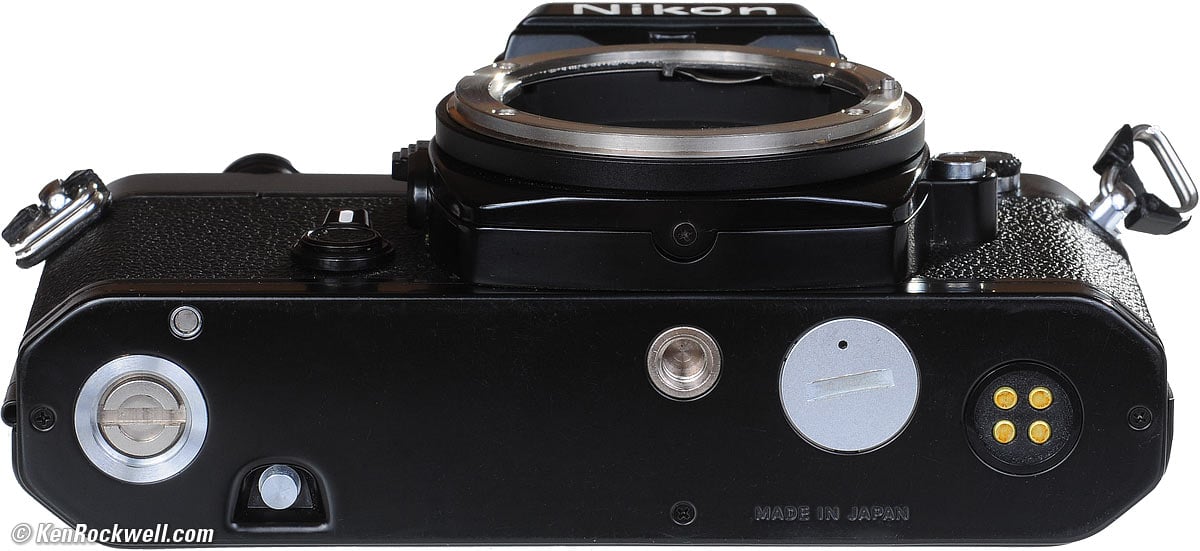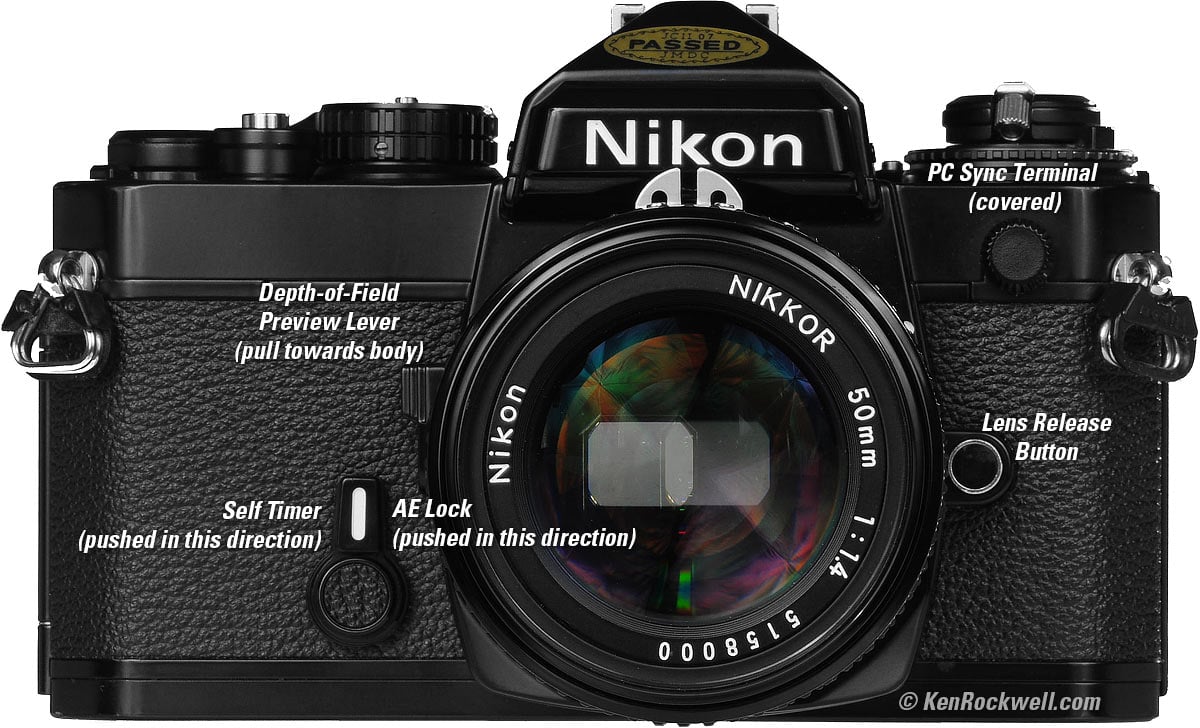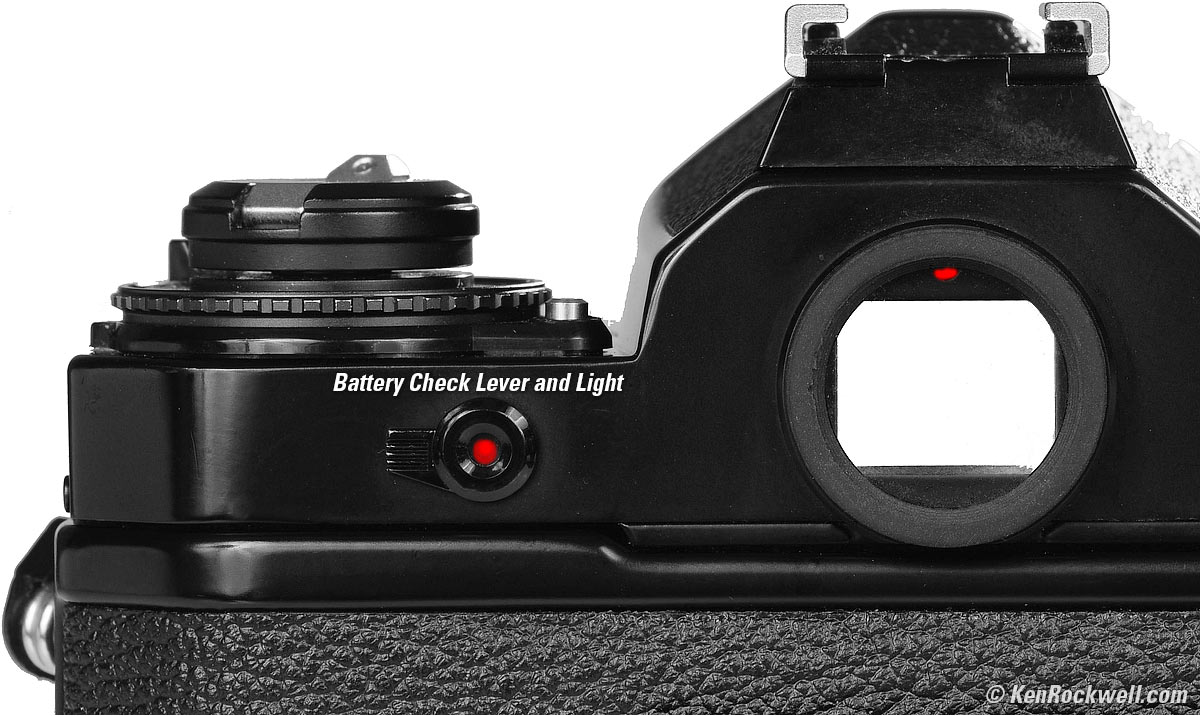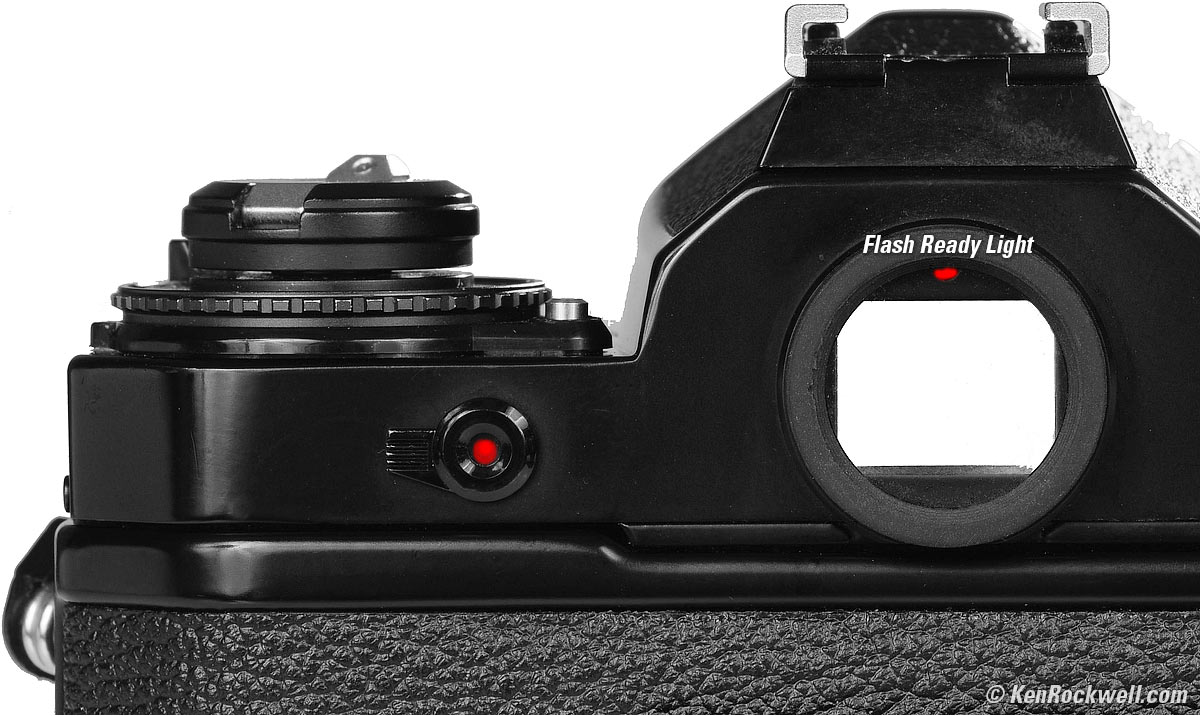Home Donate New Search Gallery Reviews How-To Books Links Workshops About Contact
Nikon FE
(1978-1983)
Nikon FE, in optional professional black (two A76 cells, 21.1 oz./599g with film and batteries, about $100 used) with 50mm f/1.4 AI-s. enlarge . You can get them used through these direct links to them at Adorama and at eBay (see How to Win at eBay), which is how I got this one. It helps me keep adding to this site when you get yours through these links, thanks! Ken.
April 2019 Better Pictures Nikon Reviews Nikon Lenses Nikon Flash All Reviews
Nikon FE and FM Family Comparison Chart
Example Photos from Arizona and New Mexico, November 2008
Film specials: transparency (slide) film B&W film color print film
I've been getting my film directly from B&H and Adorama ever since the 1970s; you've never been able to get pro film at local retail stores. I use NCPS to process and scan all my film. If you're reading this you have a mailbox and can get all the film and processing you need; B&H and Adorama ship worldwide, and NCPS does mail-order work from around the world every day.
NEW: Nikon Df (2013-)
Nikon FM3a (2001-2006)
Nikon FE2 (1983-1987)
Nikon FE (1978-1983)
Nikon EL2 (1977-1978)
Introduction top
Intro Specs Performance Usage Recommendations
|
I buy only from these approved sources. I can't vouch for ads below. |
The Nikon FE is one of my favorite Nikon cameras of all time.
The Nikon FE one of the most flexible, most intelligently designed and most perfect cameras ever made. All that, and you'd be hard pressed to spend more than $100 on one. It's easy to shoot it digitally as I show in the example.
The FE just lets me make great photos and never gets in the way. That's critical, but not something you'll ever read off a data sheet.
I love the FE. If you are thinking about getting one, just do it.
When it came out in 1978, photographers, including myself, were afraid of it because it used batteries. To us, real cameras were mechanical, and we'd be darned if we'd be caught using a sissy camera which became useless whenever its feeble batteries died.
As thirty years of history has shown, the electronic FE is at least as reliable as any Nikon mechanical camera, and its tiny watch batteries last for years, and the battery gauge gives weeks of advance notice.
The FE does everything you need, and nothing you don't. Because of this, it's easy to get to the things you do need, like setting and locking exact exposure, easy access to the AE Lock button, and a real, smooth and instantly responding analog needle instead of a stupid, slow digital display.
Photographing with the FE is joy. It just gets out of the way and lets me make loads of great pictures. Its easy to get 38 perfectly exposed shots on one 36-exposure roll of Fuji Velvia 50.
Beach Walk, Carlsbad Poinsettia. Fuji Velvia 50, 81C filter, Zoom-NIKKOR 25-50mm f/4 AI. Scanned at NCPS. bigger.
The Newer FE2
I prefer this older FE to the newer FE2 because this older FE can use every lens since 1959, while the newer FE2 can't use non-AI lenses.
This original FE uses half the battery power of the newer FE2 because the FE2 needs stronger shutter springs to get 1/4,000, and the batteries have to power the electromagnets to hold that.
I prefer the FE's power switch, which is pulling out the film wind handle, over the 16-second-per-tap shutter button switch of the FE2. My FE is always on when I need it, and the FE2 keeps turning off on me. The FE has a dedicated battery test light, while the FE2 simply stops working to tell you it's time to replace them.
Used Nikon FEs sells for around $25 and up, the deal of the century. I've never seen one break, either. FE2s cost more, because they have TTL flash and faster shutter speeds that no one uses with film.
I can shoot pictures on the leader before frame 1 on an FE, while the FE2 only shoots at 1/250 until you get to frame 1.
The FE does everything the F3 does for me, in a smaller, lighter package with a far easier to read, more precise and faster meter display, The F3 is crippled with a clumsy digital LCD instead of an instantaneous needle.
The only thing the FE can't do is work well with circular fisheyes. You can't see the transparent shutter speed indications on the left of the finder because circular fisheye images are black on the sides! Of course the FE works perfectly with all 16mm fisheyes. The FE does work with circular fisheyes like the 8mm f/2.8 and 6mm f/2.8, but it drives me crazy not being able to see the shutter speeds. Forget the ancient fisheyes that poke into the camera; the FE has no full-time mirror lock-up.
The FE has an automatic mirror-lock-up for use on a tripod, far more advanced than any of Nikon's digital SLRs. Any time you use the self timer, the mirror locks up at the beginning of the interval!
The FE is ideal for night photography. Bulb mode is mechanical, but better still is that the FE automatically times long automatic night exposures even hours long. It's not rated to do it, but try it and you'll be surprised how well it works.
The instant-response analog meter needle makes exposure easy, since applying the Zone System and AE Lock is so much more precise than dopey LED and LCD readouts, which can't indicate any more precisely than about a full or half stop and take a second to update themselves as you pan around. You easily can read the meter of the FE to a tenth of a stop.
The only gotcha is that the FE is a traditional fake-leather-covered boxy metal camera. It's not as comfortable to hold all day as a curvy block of magnesium covered in rubber, like the glove-soft F6.
If you prefer Matrix metering, get the FA, but you'll miss the superior genuinely analog readout of the FE.
Top, Nikon FE. enlarge.
The Nikon FE works, and even provides auto exposure, with every Nikon SLR lens ever made.
The FE has a uniquely wide range of compatibility because it has a flip-down aperture coupling pin for use with both AI and non-AI lenses. Nikon did it this way because the FE came out at the beginning of the AI era, so everyone had both a bag of non-AI lenses and newly purchased AI lenses they expected to use on the FE.
The only compatibility exceptions are with the 1960s fisheyes and gelded G lenses.
Gelded (G) lenses are impractical because they only work at minimum aperture.
Since the earliest f/8 and f/5.6 fisheyes and the 21mm f/4 lens of 1959 require a full-time hard mirror lockup (and external finder), they won't mount on the FE. The FE has no full-time mirror lockup, just an automatic one with the self timer.
With G lenses and non-AI lenses you must use stop-down metering and AE Lock (or manual exposure) for every shot.
Otherwise, every autofocus and manual focus lens ever made from 1959 through today works just great on the Nikon FE.
You can use all the AF (but not G) lenses, but more ironically, Nikon has made a far broader range of professional manual focus lenses than they ever have made in autofocus.
Most pros switched to Canon at the dawn of the AF era, so Nikon has never developed a full line of exotic AF lenses as they did in manual focus.
A Nikkor 13mm f/5.6 AI-s swallowing a Nikon FE. There is no autofocus substitute. enlarge.
The fastest lenses in the Nikon system, f/1.2, are only made in manual focus. You can buy the 50mm f/1.2 today.
Nikon makes no really fast wide AF lenses today. The closest AF lens is the 35mm f/2 AF, but the 35mm f/1.4, still made today, is manual focus only.
The longest lenses in the Nikon system, 800mm, 1,000mm, 1,200mm, 1,200 - 1,700mm and 2,000mm, have only been made in manual focus.
The widest lenses in the Nikon system, the 13mm f/5.6 rectilinear and 6mm fisheye, were only made in manual focus.
You're not missing anything, and the FE works great with AF lenses if you care to bother.
More at Nikon Lens Compatibility.
In 1978, the new Nikon FE replaced the earlier Nikon EL-W and EL2.
The FE was replaced by the newer FE2 in 1983.
Rear, Nikon FE. enlarge.
Specifications top
Intro Specs Performance Usage Recommendations
Type
Manual-focus 35mm film SLR. Electronic shutter with two mechanical backup speeds, mechanical advance lever. Manual (crank) rewind.
Lens Mount
Solid stainless steel, baby.
Colors
Chromed brass and black. Black was always $25 extra when new.
Film Advance
Thumb lever, or MD-11 or MD-12 motor drives.
Finder
93% coverage.
0.86x magnification w/50mm lens.
Fixed glass pentaprism.
Interchangeable screens.
Depth-of-Field Preview
Yes, press lever near lens towards body.
Meter
12mm heavily center-weighted TTL meter.
AE Lock
Yes, press and hold Self Timer lever towards the lens.
Exposure
Aperture-priority auto and match-needle manual exposure. AE Lock if you press and hold the self-timer lever towards the lens.
Shutter
A Nikon FE locked, loaded and ready for anything. enlarge.
Vertical metal focal plane shutter. Engraved shutter speed dial.
Specified for 8 seconds ~ 1/1,000 in manual and auto modes. It actually has a much wider range in Auto mode as explained under Performance.
Without batteries, it works at Bulb and 1/90.
Maximum shutter speed with flash
1/125 electronic speed, or the 1/90 mechanical speed.
Flash Sync
Hot shoe and PC sync terminal.
Flash Ready Light
Red L. E. D. (light-emitting diode) right above the external eyepiece.
Works with Nikon dedicated flash.
TTL Flash?
No.
You need the FE2 for that.
Film Back
Removable.
Weight
21.136 oz. (599.1g) measured with with batteries and film.
20.355 oz. (577.1 g), measured with (2) LR44 alkaline batteries, big rubber eyecup and strap lugs, but without strap, without lens and without body cap.
Nikon specifies 590g.
Never-Ready Case
The fitted eveready case for use with short lenses is the CF-27.
The CF-28 is for long lenses. The CF-28A is just the longer top section that fits both cases.
Power
Two S76 or A76 cells, or one 3V 2L44 lithium.
It runs for years on a pair.
Price, USA
Used
From 2013 through 2018 it's sold for about $100 used if you know How to Win at eBay.
New
When new in January 1979, the silver model FE body-only sold for $330 at B&H, which is $1,130 in 2018 with inflation ($1,050 in 2013).
The balck verison sold here cost about $25 extra.
Only the smartest pros bought at B&H back then; most people still paid too much at retail.
Performance top
Intro Specs Performance Usage Recommendations
Nikon FE and 50mm f/1.4 AI-s. enlarge.
Ergonomics
The FE is all about shooting. It just goes.
The only thing it won't do is let you see the meter reading in the dark, since it reads via a needle in the finder. There is no light, which is why the battery least most of a decade, but if you want to read the needle in the dark, you'll need something with some light in your subject.
The great news is that the log-scale meter needle makes exposure far easier to set in tough situations than any other digital readout. You simple move the camera around, note the brightest and darkest parts of your composition, and it's trivial to pick the exposure setting you prefer. It takes a minute of mental gymnastics to do the same on any camera with a digital shutter-speed readout.
The FE has real knobs so you can change settings like a man. Each knob does only one thing, so it's much easier to use than newer cameras where unneeded features choke your ability to get to the ones you do need.
Meter and Shutter Accuracy
The FE's meter is more accurate than most people's ability to use it properly.
I've never seen any error in the electronic shutter or meter.
Meter and Shutter Range
The manual settings are fixed at full stops from 8 seconds to 1/1,000.
The Auto mode also selects shutter speeds seamlessly, so if perfect exposure is 1/234 second or 3.1415926 seconds, that's what you'll get.
Even though Nikon only specifies the Auto mode to cover the same range, in actuality the Nikon FE's Auto range covers from exposure times longer than an hour to about 1/4,000 of a second!
Battery Life
Battery life was rated as "about a year." In actual use, each set has lasted me about five years or more.
Since I easily can fit three extra sets of A76 cells in my wallet, I can carry 20 years of power on me and not even know it.
A76 cells are sold everywhere, and if not, you'll find them in all sorts of trinkets like laser pointers, noisy kid's toys and keychain lights.
Film Economy
Unlike most newer cameras that automatically wind past (or won't expose properly) the first few frames, you can shoot every frame with perfect exposure in an FE.
I usually get 38 or 39 shots per roll, shooting from frame 0 through frame 37 or 38. This alone pays for an FE.
Cold Weather
My FE loves working in 25ºF (-5ºC) weather for hours at a time.
Weaknesses
The black foam used as a mirror cushion in the the mirror box and as light seals on the back of the camera turn to nasty black goo. Any camera repair shop can replace these while you wait.
I did see one that wouldn't always work at the top speeds. If set to 1/1,000 manually, or if the auto exposure setting wanted a high speed, it would flip up the mirror and hang. To unhang it, you needed to turn the shutter dial to M90 and try again. Oddly, that sample of camera would get better with use, and get worse if left unused.
Service
Nikon no longer has parts for the FE.
As of August 2007, they still do have some limited parts for the newer FE2.
Most independent service men can work on the FE.
Usage top
Intro Specs Performance Usage Recommendations
Film Loading and Shooting
Nikon FE, open back. enlarge.
Thread the film the usual way into the take-up spool. Close the back and wind ahead.
The film speed must be set manually on the dial over the film canister.
You can shoot starting and get good results on the second frame after you close the back, before you get to frame 1. You can shoot frame 0 and usually frame 00.
Unlike newer cameras like the FE2, the FE doesn't default the shutter speed to a fast fixed speed while loading. The only downside to this is if you leave the lens cap on and the FE set to Auto, in which case the shutter opens indefinitely for a dark time exposure. If you do this, close the shutter by pushing the wind lever forwards to turn off the FE, or rotate the the shutter dial to 1/1,000, to keep advancing the film.
The frame counter stops counting at 36, although you can keep going as long as you have film.
When the roll's done, press the rewind button on the bottom and turn the crank on the top to rewind the film back into the canister.
Bottom, Nikon FE. enlarge.
There are no silly threaded bottom caps to lose. The motor drive connections just sit out like this.
Finder
Live Aperture Direct Readout (ADR) shows the aperture setting directly from the lens' aperture ring.
Live analog meter needle indicates metered value and automatically selected speed.
Transparent green needle shows position of shutter-speed dial, including AUTO and manual settings.
Finder Screens
The FE takes the standard K screen, as well as the E or B screens.
Trick: You can use the K2, E2 and B2 screens from the newer FE2, and get a brighter finder! You have to dial in +1/2 stop of exposure compensation, since more light goes to your eyes and to the meter.
I suspect the FE also will work great with the even newer K3 screen from the FM3a, but have no idea of the exposure compensation needed.
You can identify the -2 screens because they have a small notch in their index tab.
Metering
Nikon FE Front Controls. bigger.
The FE meters mostly within the big circle in the middle of the finder.
If the light is uneven, put that over your subject, push the self-timer lever (the one with the white line on the front of the FE) towards the lens to lock that exposure, recompose and shoot.
The Nikon FE does not indicate that you're locked the exposure. You just have to trust it and the meter continues to read the current light. The FE2 is different: its meter needle locks when you press the AEL lever. The advantage to the FE is that if you remember the position of the needle when you hit AEL, it's easy to use the Zone System and see directly how subjects place as you pan around. On either camera you can set a manual speed and the green needle stays put while the black light meter needle shows you your zone placements.
Trick: ASA is set in third stops, and exposure compensation is set in half stops. If yo know math, you can use this to set automatic exposure bias in sixths of a stop.
Long Exposures
The FE's internal circuitry is analog, so it has none of the hard range limits of newer cameras with digital circuitry.
If you shoot scenes at night, the FE will meter and clock-off time exposures automatically. Forget newer cameras which require you to sit there like a dork holding a cable release while watching a wristwatch and holding a flashlight to see it all.
With an FE (or FE2 or FA), compose the scene, cover the eyepiece if your eye isn't on it, wind the self timer, and press the shutter.
The FE measures and locks the exposure, flips up the mirror, counts off about ten seconds, and then makes the time exposure automatically.
You don't need a cable release, and the mirror locks up and returns all by itself. It is way, way superior to any digital Nikon.
I've never had the patience to wait around and see just how long the Nikon FE will expose.
Out of curiosity, I loaded fresh A76 cells into an FE set to ASA 50 and, with the lens cap on in AUTO, pressed the shutter.
The shutter stayed open for 63 minutes, and then closed at ISO 50. Whoa!
I tried it again set to ASA 400, and the FE stayed open for 3 minutes and then 17 minutes. It will vary by temperature and the amount of light to which the FE was exposed a little while before you started the exposure. Remember, the FE is analog, and it's the leakage currents which are defining the long exposure times.
These times correspond to LV -13 with an f/1.4 lens, which is about ten stops darker than normal night time.
These times are with a wide-open lens. The FE calculates even longer times if you stop down your lens!
The FE doesn't calculate corrections for reciprocity failure. Luckily, the lessened effective exposure with most film gives the darker results we want to make night shots look like night; otherwise night shots would look as bright as day.
The battery check light works during a long exposure.
Above 1/1,000
At higher speeds, you can get to about 1/8,000, but what happens at these higher speeds is that they can become inaccurate, and your exposures will vary. That's why Nikon didn't specify the FE for speeds above 1/1,000.
If you get to know your camera and how its exposure varies at these higher speeds, you can shoot them. The black needle in Auto mode will cross the "A" and above.
Don't worry if the needle only goes a fraction of a stop above 1/1,000 in auto; exposure will be perfect.
Power and Batteries
Nikon FE battery test lever and light. bigger.
Flick the lever to test the batteries. It stops working before the Nikon FE does, so you get plenty of notice to change them.
When the meter is off, the batteries are completely disconnected just as if they were sitting in their packaging on a store shelf.
If you keep shooting long after the test light stops lighting, when the batteries drain to 2.8V, the meter and the FE still shoots, but the mirror stays locked up after the exposure. Spin the shutter dial to M90 to get the mirror back down, and replace the batteries!
The A76 button cells are so tiny that it's trivial to keep a spare pair in your wallet. Even in their blister packs, I can fit three sets (six cells) and not even notice them. The batteries last so long that it's unlikely that they'll see much action, just like the condoms I used to carry but never seemed to need. I got years out of a set of either.
If you like to travel lighter, you can buy either of them at any grocery store (or Radio Shack for the batteries).
I buy A76 (same as LR44) batteries wholesale for about 30¢ each, or you can buy certain kids' toys at Wal-Mart for 99¢ and cannibalize their LR44 batteries. My kid loves his noisy 99¢ toy phone, so I'm not cannibalizing his toys — yet.
Just as slides fit in a projector eight different ways, but seven of these ways are wrong, the two A76 cells that power the FE can go in many ways that don't work. If you get no battery check light, be sure both cells are loaded correctly.
Flash
The Nikon FE's flash ready light is above the finder. bigger.
The FE switches to 1/125 when a flash is ON and the FE is set to AUTO. The meter needle shows the ambient light, making it easy to set light ratios.
If you want slow sync, set the manual shutter dial as you want, looking at meter to set the fill ratio.
The FE stays at 1/125, even while the flash is recycling.
There's no TTL, but the FE does show a ready light at the top of the viewfinder which can blink to tell you things.
The hot shoe has no extra hole for the lock pins of newer flashes, so shoe-mounted flashes can back themselves out.
To get even more years of life from the batteries, you can shoot flash at the mechanical 1/90 speed.
When using flashbulbs, which were still somewhat popular for high power when the FE was introduced in 1978, the maximum suggested shutter speed is 1/30, since the FE lacks the specialized M sync modes of older cameras for most flashbulbs.
The flash ready light blinks if something's not right and the meter is on, like:
If you set the manual shutter speed above 1/125, the ready light blinks at 2 Hz. If you set a faster manual speed, the FE fires at the faster speed and only part of your picture will be exposed to the flash.
If the flash is set to TTL mode, the light blinks at 3 Hz. (The FE doesn't do TTL flash; you need the FE2 for that.)
The SB-600 has no A mode, but works great in manual. The SB-600 goes to sleep in standby mode, but doesn't wake up when camera comes back on. With the SB-600, use ON, not SBY, mode.
The SB-22 goes to sleep. To wake it up you must shoot off a frame, after which the SB-22 wakes back up. While the SB-22 is asleep, the FE doesn't know it's there, and will give you a slow shutter speed in Auto; it will not fire the flash and will correctly give no ready light.
Multiple Exposures
For multiple exposures, just hold the lever coaxial with the wind crank as you cock the shutter.
Recommendations top
Intro Specs Performance Usage Recommendations
Don't get one; get two!
See also my combination Nikon FE/FM page.
© Ken Rockwell. All rights reserved. Tous droits réservés. Alle Rechte vorbehalten.
© Ken Rockwell. All rights reserved. Tous droits réservés. Alle Rechte vorbehalten.
Help Me Help You
I support my growing family through this website, as crazy as it might seem.
The biggest help is when you use any of these links when you get anything. It costs you nothing, and is this site's, and thus my family's, biggest source of support. These places always have the best prices and service, which is why I've used them since before this website existed. I recommend them all personally.
If you find this page as helpful as a book you might have had to buy or a workshop you may have had to take, feel free to help me continue helping everyone.
If you've gotten your gear through one of my links or helped otherwise, you're family. It's great people like you who allow me to keep adding to this site full-time. Thanks!
If you haven't helped yet, please do, and consider helping me with a gift of $5.00.
As this page is copyrighted and formally registered, it is unlawful to make copies, especially in the form of printouts for personal use. If you wish to make a printout for personal use, you are granted one-time permission only if you PayPal me $5.00 per printout or part thereof. Thank you!
Thanks for reading!
Mr. & Mrs. Ken Rockwell, Ryan and Katie.
